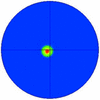issue contents
January 2020 issue

editorial
NEUTRON | SYNCHROTRON
AI is no magic dust: for it to become a true discovery accelerator, much work is needed to make it transparent and robust.
scientific commentaries
BIOLOGY | MEDICINE
Guevara, Rodriguez-Banqueri et al. [(2020), IUCrJ, 7, 18–29] determine crystal structures of mirolysin, a metalloprotease that helps oral pathogen Tannerella forsythia evade the human immune response. The structures provide insight into the regulation and specificity of mirolysin, and hint at how it might be inhibited for therapeutic effect.
research letters
CHEMISTRY | CRYSTENG
Download citation


Download citation


3D electron diffraction has been used to follow polymorph evolution during the crystallization of glycine from pure water. All three known polymorphs formed sequentially in samples taken from the same solution and allowed to crystallize in situ at times between 3 and 60 min. Crystal structures were obtained for all three phases.
research papers
PHYSICS | FELS
A refinement method of the structure from a low-intensity diffraction pattern is proposed and applied to a diffraction pattern from a sub-micrometre cluster. It is shown that the method could retrieve a 2D projection of the electron density that is physically meaningful.
BIOLOGY | MEDICINE
The members of the unicellular pappalysin family of metallopeptidases are secreted as zymogens with a short N-terminal pro-segment, which blocks the catalytic zinc cation by a cysteine-switch mechanism, as shown structurally for bacterial mirolysin. This is a mechanism to prevent activity in the absence of the adequate temporal and spatial requisites. In addition, the complex of mirolysin with a large peptide reveals the structural basis of its catalytic mechanism.
PHYSICS | FELS
This work demonstrates the use of polymer thin films and graphene to support and maintain the hydration of protein microcrystals on fixed targets for serial femtosecond crystallography at X-ray free-electron lasers. Rapid encystment protein (REP24) provides a benchmark for this encapsulation approach.
MATERIALS | COMPUTATION
Contributions to plasticity from hard matrix and binder metal in nanocrystalline cermets were studied by molecular dynamics simulations.
CHEMISTRY | CRYSTENG
The effect of substrate temperature, growth rate and film thickness on the crystallographic characteristics of polycrystalline Bi thin films by molecular beam epitaxy and semimetal–semiconductor transition are discussed. Meanwhile, a structure-zone model and a two-transport-channels model are introduced to explain the crystal growth characteristics and the semimetal–semiconductor transition.
MATERIALS | COMPUTATION
Download citation


Download citation


Pyridine phase III, which forms at 1.69 GPa, is tetragonal and related to the previously characterized orthorhombic form II by a displacive phase transition. Phase III is similar to a high-pressure form of benzene. The soft mode governing the III→II transition has been identified using a combination of symmetry mode analysis and periodic density functional theory. A combination of single-crystal X-ray diffraction and Raman spectroscopy is used to resolve ambiguities in previous work on pyridine.
BIOLOGY | MEDICINE
Download citation


Download citation


Experimental and theoretical electron density distributions and the nature of intermolecular interactions of bicalutamide in its monoclinic polymorph and in androgen receptor complexes are reported.
CCDC reference: 1954089
CHEMISTRY | CRYSTENG
Download citation


Download citation


Single crystals of three isotypical Cu(II) coordination complexes with paddlewheel structures exhibit mechanical motion while undergoing [2+2] cycloaddition under UV light (photosalient effect), and also exhibit large positive thermal expansion on heating.
BIOLOGY | MEDICINE
The structure of human MICAL3 provides information about its mechanism.
PDB reference: human MICAL3, 6ici
MATERIALS | COMPUTATION
A thermoelectric operando setup for synchrotron X-ray scattering has been developed in order to study the operational stability of thermoelectric materials in real-world conditions.
CHEMISTRY | CRYSTENG
Download citation


Download citation


Co-crystals of the commercially available anticancer aromatase inhibitor exemestane (Ex) and guest co-former thiourea were synthesized and the difference in the biological properties of the co-crystal compared with Ex was investigated. To study the various intermolecular interactions and their contribution to the structure stability, Hirshfeld surface analysis was successfully employed, and thermal stability was evaluated by DSC and TGA.
MATERIALS | COMPUTATION
The structural, electronic, magnetic and transport properties of half metallic Co2−xRuxMnSi (x = 0–1) Heusler compounds are studied both theoretically and experimentally. Our computations and experiments soundly agree with each other.
CHEMISTRY | CRYSTENG
Download citation


Download citation


Ilmajokite, a natural titanosilicate found in the Russian Arctic, has an extraordinary complex microporous framework structure consisting of several levels of hierarchical organization.
CCDC reference: 1971431
BIOLOGY | MEDICINE
An increase in crystal lifetime resulting from photoelectron escape was measured on the microfocus beamline I24 at Diamond Light Source for hen-egg white lysozyme microcrystals mounted on cryo-TEM grids at 13.5 and 20.1 keV using a PILATUS CdTe detector.
NEUTRON | SYNCHROTRON
The Guinier law for magnetic SANS on bulk ferromagnets is introduced and applied to the analysis of nanocrystalline cobalt. The magnetic-field-dependent Guinier radius reflects the characteristic microstructural size and depends on the magnetic interactions.


 journal menu
journal menu




 access
access































